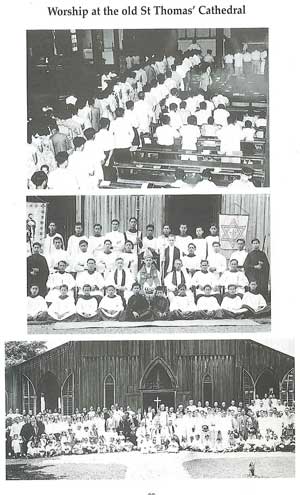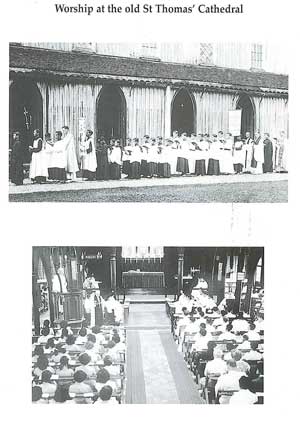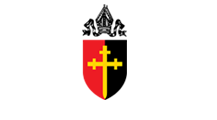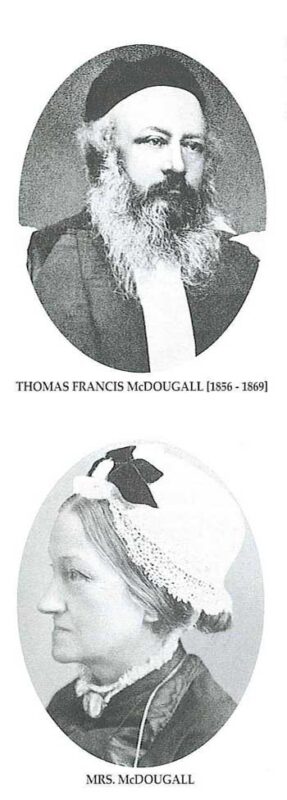
“Theirs was a true pioneering life; everything had to be started from scratch” Thomas Francis McDougall was a Fellow of the Royal College of Surgeons before he took Holy Orders. He was ordained in 1845, and after holding curacies in England he was requested by the Rajah of Sarawak to start an Anglican mission in his equatorial principality.
Dr. and Mrs. McDougall reached Sarawak in 1848. Theirs was a truly pioneering life; everything had to be started from scratch. A Church and a Mission House were built, instruction of school children and prospective converts was organised; and Dr. McDougall’s services as a doctor were much in demand. Mrs. McDougall were as active as her husband, especially in the field of education. She shared the common lot of ‘colonial wives’ in that she had to leave her young family behind in England; of the babies born in Kuching most died.
Some of the most touching records of the Mission’s early days are found in Mrs. McDougall’s letters to her young son at school in England, later published as ‘Letters from Sarawak’.McDougall was consecrated Bishop of Sarawak in 1856.
During his time, the strong foundation of the Anglican church in Borneo was laid: the urban mission was never allowed to supersede the needs of the rural people who lived in a far-flung land of difficult access.Bishop McDougall was ordered to leave the tropics on medical advice in 1867.
He kept in close touch with Sarawak and its affairs during the next twenty years, when he served as Bishop of Ely and then Winchester.
“Chambers visited various rural areas and founded outstations …where he acquired fluency in the Iban language and a good understanding of his flock’s customs and traditions.”
Walter Chambers was born on Dec.17,1824 in Mansfield, Nottinghamshire. He was ordained in the Diocese of Lichfield in 1849 /1850, and served as curate at Fenny Bentley in Derbyshire. Chambers arrived in Sarawak in March 1851, and was initially posted to the Skrang. Because of political unrest at the time, he moved downriver to Banting where he pioneered missionary work among the Balau Iban. He brought his first four converts to Kuching to be baptized on Christmas Eve 1854.
Chambers visited various rural areas and founded outstations as far afield as Undup, but his headquarter was at Banting, where he acquired fluency in the Iban language and a good understanding of his flock’s customs and traditions. He translated Christian literature into the native tongue; he started a school in Banting which, especially after his marriage in 1856, did much to plant the good seed.

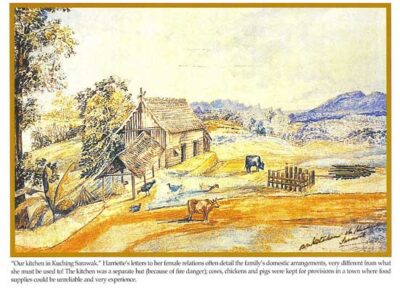 In his wife, Elizabeth Wooley, Chambers found a useful companion to share the hardships and joys of ‘outstation life’ in Sarawak. Her presence at Banting drew the women to the church; in a letter, Mrs.McDougall described the school girls who ‘follow Lizzy around everywhere’.
In his wife, Elizabeth Wooley, Chambers found a useful companion to share the hardships and joys of ‘outstation life’ in Sarawak. Her presence at Banting drew the women to the church; in a letter, Mrs.McDougall described the school girls who ‘follow Lizzy around everywhere’.
Chambers was appointed Archdeacon of Sarawak in 1868, and followed T.F.McDougall as Bishop of Sarawak consecrated by Tait on 29 June 1869. He was installed in Kuching on 5 June 1870 as Bishop of Sarawak and the Straits Settlements. Now settled in Kuching, he continued his ministrations to the Dayak areas, besides visiting Singapore annually.
In his first synod of 1871 he planned to have a central school for the Dayaks; St.Thomas’s School in Kuching which building during this period. In his second synod he put forward his vision of a self-supporting Church. 1874 he went on home furlough, taking the 17-year-old mission scholar William Howell with him.
The loss of his wife in 1875 was a severe blow to Chambers; he was not robust but he returned to Sarawak and his episcopal duties. Ill health forced him to resign in 1881; he was a complete invalid until his death on Dec.21, 1893. Chambers’ reputation tends to suffer from comparison with his forceful, genial predecessor, McDougall. Many contemporaries saw him and Mrs.Chambers as narrow-minded, though both deserve to be remembered as tireless workers and enthusiastic evangelists who literally gave their health and finally their lives to their joint vocation.
Chambers’ episcopal visitations were not leisurly progresses, but working trips. At the time of his collapse, the ageing Bishop had been in the stages of planning a three-month ministry in Banting, and so he wore out his strength.
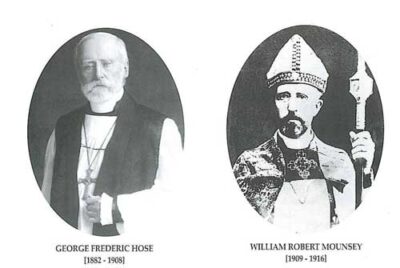 “Hose is credited with having planted the first rubber seeds in Borneo”.George Frederic Hose was ordained at Ely in 1861/62.
“Hose is credited with having planted the first rubber seeds in Borneo”.George Frederic Hose was ordained at Ely in 1861/62.
He served as a missionary in the Straits Settlements, and was made Archdeacon of Singapore in 1875. He was consecrated Bishop of Sarawak and Singapore in May 1881.Bishop Hose was enthroned in Kuching on 17 Jan 1882. He was a tireless traveller and from the beginning made regular tours of the rural areas. He was equally thorough in his administration of Singapore and Malaya. He urged people to construct temporary prayer houses if there was no proper church. He encouraged the appointment of lay readers and teachers in the rural area; his wife re-opened the girls’ school in Kuching.
The Dayak ministry blossomed under Hose. He organised the first Iban conference in 1893, and expanded mission work in Sabah. He ordained W.Howell, and recruited E.H.Gomes from Singapore, and (Archdeacon) Sharp, who sparked new life into the Church in Borneo. Some of the older missionaries (Fowler, Zehnder) retired or died during this episcopate.
Hose’s last years were a time of relative stagnation. With the death of his wife, Hose lost not only a cherished life partner, but also a competent fellow-botanist (Hose is credited with having planted the first rubber seeds in Borneo).
The ageing bishop continued to administer his two bishoprics as well as he could; after more than forty years in the tropics he was reluctant to leave the scene of his labours. Bishop Hose left Kuching in 1907 and resigned in November 1908.William Mounsey was consecrated Bishop of Labuan and Sarawak in 1909. He was was occupied for eight years in restructuring the Diocese after its separation from Singapore; upon arrival here he found a very small staff, and few material resources.
He was a stern, pious man in his way, strict with his staff and not always popular. But his successor found a well-administered church, its finances in order and its machinery running smoothly and the schools expanding. After his resignation from Sarawak, Bishop Mounsey joined the Community of the Resurrection, and became Assistant Bishop of Truro and later Bradford. He passed away in June 1952.
 Logie Danson was bom in Aberdeen, Scotland, where he served as a curate after his ordination. His first posting in the East was at Seremban in Negri Sembilan in 1911.
Logie Danson was bom in Aberdeen, Scotland, where he served as a curate after his ordination. His first posting in the East was at Seremban in Negri Sembilan in 1911.
After his consecration as Bishop of Kuching, he came to Sarawak in 1918. His episcopate was a period of much building activity, outreach among the Iban, and serious promotion of the indigenous ministry.
After his retirement from Sarawak, he served as Provost of St.Mary’s, Edinburgh, and later Bishop of Edinburgh. He passed away in December 1946.

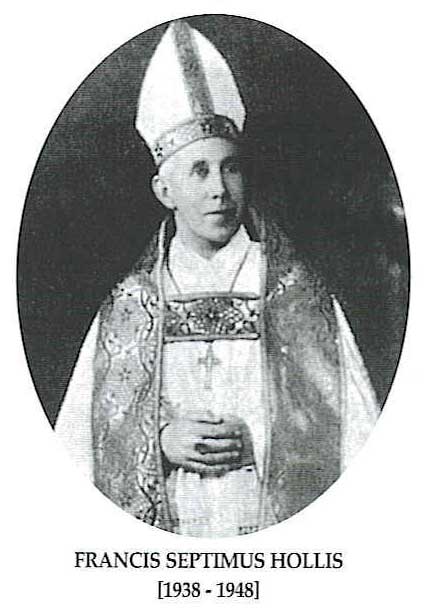
Noel Baring Hudson had been vicar of St.John’s, in Newcastle-upon-Tyne, when he was called to Sarawak in 1931. His arrival here coincided with the worst part of the depression. He husbanded the scarce resources to the best of his ability. The Ordination Test School for training local clergy was started during Hudson’s episcopate, when he invited the Mirfield fathers work in the Diocese.After his resignation from Sarawak Hudson became Secretary of the SPG, Bishop of St.Albans, Newcastle and later Ely. He passed away in October 1970.
Francis Hollis was trained for the sacred ministry at Dorchester Missionary College, where he was ordained in 1913/14. He came to Sarawak in 1916 and served at the Cathedral and as principal of St.Thomas School until 1923, when he was put in charge at St.James Quop. He was made Archdeacon of Sarawak in 1934, and consecrated Bishop of Sarawak in 1938.
Hollis’ episcopate was violently disrupted by the war. Internment from 1941 to 1945 seriously undermined his health, and in 1948 he resigned the see after 32 years of service in Sarawak. He served as Assistant Bishop of Leicester until he passed away in February 1955.
 Nigel Cornwall was consecrated Bishop in Westminster Abbey on 1 November 1949 and enthroned as Bishop of Borneo on 20 December the same year in Kuching. He had been a missionary in the Diocese of Masai, Tanganyika, from 1939, and from 1944 had been headmaster at Chidya.
Nigel Cornwall was consecrated Bishop in Westminster Abbey on 1 November 1949 and enthroned as Bishop of Borneo on 20 December the same year in Kuching. He had been a missionary in the Diocese of Masai, Tanganyika, from 1939, and from 1944 had been headmaster at Chidya.
After the war and prior to his consecration he also worked as a missionary in Ceylon (now Sri Lanka). His episcopacy coincided with the post war reconstruction and preparation for Sarawak’s independence within Malaysia. As a means of training local men for the priesthood a theological school – the present House of the Epiphany- was started in 1952.
The highpoint of his episcopate was the construction of the new St. Thomas’s Cathedral in Kuching. It was also during his time that the Centenary of the Founding of the Anglican Church in Borneo was celebrated on a grand scale. (The celebrations did not take place till 1955, seven years late, because of the conditions prevailing in Sarawak following the devastating World War and the effects of the Japanese occupation). For nearly one and a half years, till April 1956, he acted as the principal of St. Thomas’ School. The policy of the Mission at that time was that the Principal must be a missionary and if possible a priest. He decided to carry out the duties of the principal, himself till Rev. Norman Keen came to take charge of the school.
Whenever he could afford the time, he traveled widely visiting parts of the diocese. To prepare himself to cope with the harsh conditions available in the stations in the interior, he used to sleep on the floor in the Bishop’s house. Nigel Cornwall was a keen sportsman. He had played hockey for the All European Team while in Ceylon and turned up for, the Kuching Civilians’ hockey team regularly. Late in life, in 1960, he married another Missionary worker whom he had met while working in Ceylon. During one of his sermons he was to declare,
“In the past I used to talk about love and preach about love. But until I met her and married her, I did not know the real power of love”. Nigel Cornwall returned to England in September 1962 and for a time served as the Assistant Bishop of Wichester. He passed away in 1984.
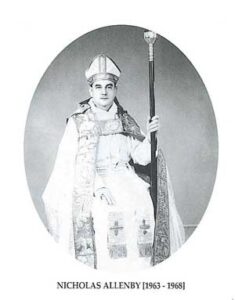 “He was the first Bishop of Kuching, after the Diocese of Borneo had been divided to cater for the East Malaysian states of Sarawak and Sabah…”
“He was the first Bishop of Kuching, after the Diocese of Borneo had been divided to cater for the East Malaysian states of Sarawak and Sabah…”
Nicholas Allenby was trained at the Sacred Mission Theological College at Kelham, and became a monk of the Society in 1933. After a career in pastoral and teaching work, he was sent to Adelaide in 1957 as a Provincial.
In 1962, the Rt. Rev Nicholas Allenby was called to Kuching, where he was enthroned on the 13th January 1963. He was the first Bishop of Kuching, after the Diocese of Borneo had been divided to cater for the East Malaysian States of Sarawak and Sabah (North Borneo). It was a period of political development, not without danger; the first three years of Allenby’s episcopate were marked by threat of military aggression from a neighbouring country.
The Rt. Rev. Allenby first mooted the possibility of a Province of South Asia in 1963. He was energetic in promoting the setting of a Ministry Fund to make the Church entirely self-supporting. Among the achievements of his episcopate were the establishment of the first church at Bunuk, the appointment of the Rev. Michael Lim as the first Sarawakian Dean of St. Thomas Cathedral, and of the Rev. (later Bishop) Basil Temenggong as Archdeacon.
In 1967 the new parish of St. Faith’s was set up to serve the urban spread of Kuching. In 1968 the then redundant Boarding House of St. Mary’s was converted into a Diocesan Centre and Guest House.After his retirement from Sarawak in 1968, Allenby served as Bishop of Worcester for 16 years. He spent his old age in the hospice in Willen, Milton Keynes, under the care of his Kelham brothers.
 “Basil Temenqgong was the first Sarawakian and the first Iban to be made Bishop in the Anglican Church.” Born on 11 October 1918 at Pasa, an Iban longhouse about a mile down river from Betong, Basil Temenggong was fortunate to be able to obtain an early education in the mission school of St. Augustine’s in Betong.
“Basil Temenqgong was the first Sarawakian and the first Iban to be made Bishop in the Anglican Church.” Born on 11 October 1918 at Pasa, an Iban longhouse about a mile down river from Betong, Basil Temenggong was fortunate to be able to obtain an early education in the mission school of St. Augustine’s in Betong.
He excelled in his academic performance and gained most of the prizes, including the coveted Scripture prize. Even at his young age, he already showed a liking for the things of God – busying himself attending to the chores of the Church. His classmates dubbed him as the ‘small priest’. After completing standard 6, the highest available education in Betong in those days, Basil continued his education at St. Thomas’ School in Kuching. He completed the Junior Cambridge, the highest academic qualification available in the town.
He returned to teach in Betong, and shortly after this he came to realise his true vocation. He responded favourably to God’s call and offered himself for the Sacred Ministry. Thus in 1939, Basil was sent to Calcutta for his theological training at Bishop’s College, a college where a number of expatriate priests had been trained before. On 16 November 1941, he was ordained deacon by Bishop Tarafdar in Calcutta and was licensed to serve as Assistant Chaplain in St. Thomas’ Cathedral, Calcutta.
On 11 April 1943, he was ordained to the priesthood by the Bishop of Calcutta. He was then posted to Asansol, and because of the wartime condition, very often he found himself ministering to allied soldiers massing at the border, waiting for a final push against the Japanese.
On his return from India in 1946, Basil was posted to Betong to look after the parish. He later became headmaster of his former school, St. Augustine’s, while at the same time continuing to assist in the pastoral ministry of the Church. Basil was transferred to Kuching in 1954.
In 1954, Basil was sent to England where he did a year post-Ordiantion course at St. Augustine’s College, Canterbury. He also spent time with the Community of the Resurrection at Mirfield, and also at the Parish of All Saints in London. On his return from England, Basil was posted to Saratok to look after that large rural parish. Being a tireless traveler, he visited all corners of the parish and even opened areas like Plassu in the Nyabor. He was made Canon in 1960, and Archdeacon in 1962. He was priest in charge of St Luke’s from 1965 to 1968.
When Nicholas Allenby resigned on 31 October 1968, Basil Temenggong was the unanimous choice to replace him. So on 6 December 1968, Basil Temenggong was consecrated bishop, and two days later was enthroned at the Cathedral as the tenth Bishop of the Diocese of Kuching.
During his tenure of office, he served as the Chairman of Churches of East Asia from 1979 to 1983. He was an active participant and a great advocate of the Partners-in-Mission. He was a staunch supporter of the Council of Churches of Malaysia, and served as one of its vice-presidents from 1981 to 1982. In 1983, he was protem Chairman of the then proposed Association of Churches in Sarawak, and as its Chairman after its registration hi August 1984.
He was conferred the Panglima Negara Bintang Sarawak (PNBS), which carries the title ‘Datuk’, by. the Governor of Sarawak in recognition of his service not only to the Church but to the country as well.
Bishop Basil served at a time when the Church in Borneo was trying to stand on her own feet and to develop a truly Asian ministry brought by the political changes accompanying Independence within Malaysia. His foresight, able leadership and quiet diplomacy steered the Church safely through this difficult transitory period. He was always a dedicated worker for Christ, and despite his heart’s condition, he laboured tirelessly in discharging his episcopal duties. It was in the midst of performing a confirmation service at Simunjan on 22 September 1983 that his poor heart beat for the last time. His death was instantaneous.
Basil Temenggong was the first Sarawakian and the first Iban to be made Bishop in the Anglican Church, and his 16 years in the episcopacy was the longest so far in the Diocese. He was also the first bishop of the Diocese to die in office.
On his return from India in 1946, Basil was posted to Betong to look after the parish. He later became headmaster of his former school, St. Augustine’s, while at the same time continuing to assist in the pastoral ministry of the Church. Basil was transferred to Kuching in 1954.
In 1954, Basil was sent to England where he did a year post-Ordiantion course at St. Augustine’s College, Canterbury. He also spent time with the Community of the Resurrection at Mirfield, and also at the Parish of All Saints in London. On his return from England, Basil was posted to Saratok to look after that large rural parish. Being a tireless traveler, he visited all corners of the parish and even opened areas like Plassu in the Nyabor. He was made Canon in 1960, and Archdeacon in 1962. He was priest in charge of St Luke’s from 1965 to 1968.
When Nicholas Allenby resigned on 31 October 1968, Basil Temenggong was the unanimous choice to replace him. So on 6 December 1968, Basil Temenggong was consecrated bishop, and two days later was enthroned at the Cathedral as the tenth Bishop of the Diocese of Kuching.
During his tenure of office, he served as the Chairman of Churches of East Asia from 1979 to 1983. He was an active participant and a great advocate of the Partners-in-Mission. He was a staunch supporter of the Council of Churches of Malaysia, and served as one of its vice-presidents from 1981 to 1982. In 1983, he was protem Chairman of the then proposed Association of Churches in Sarawak, and as its Chairman after its registration hi August 1984.
He was conferred the Panglima Negara Bintang Sarawak (PNBS), which carries the title ‘Datuk’, by. the Governor of Sarawak in recognition of his service not only to the Church but to the country as well.
Bishop Basil served at a time when the Church in Borneo was trying to stand on her own feet and to develop a truly Asian ministry brought by the political changes accompanying Independence within Malaysia. His foresight, able leadership and quiet diplomacy steered the Church safely through this difficult transitory period. He was always a dedicated worker for Christ, and despite his heart’s condition, he laboured tirelessly in discharging his episcopal duties. It was in the midst of performing a confirmation service at Simunjan on 22 September 1983 that his poor heart beat for the last time. His death was instantaneous.
Basil Temenggong was the first Sarawakian and the first Iban to be made Bishop in the Anglican Church, and his 16 years in the episcopacy was the longest so far in the Diocese. He was also the first bishop of the Diocese to die in office.
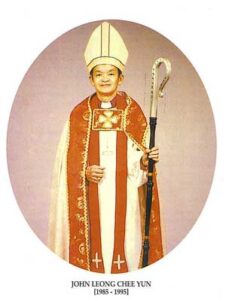 Bishop John Leong was consecrated on 17.5.85 and enthroned on 19.5.85 at St Thomas’ Cathedral, Kuching.
Bishop John Leong was consecrated on 17.5.85 and enthroned on 19.5.85 at St Thomas’ Cathedral, Kuching.
His interest in the Christian faith prompted him to serve as Lay Reader in the Seria/Kuala Belait parish from 1950 to 1959 and in Miri/Lutong from 1960 to 1974.
He was made Sub-deacon in October 1974 and Deacon on 9.3.75. After he was priested on 14 December 1975 he served as a non-stipendiary priest at St Columba’s Church, Miri, and became its Vicar in April 1984. He was also a founder member of St Margaret’s School in Seria, Chairman of the School Board of St Columba’s Primary and Secondary Schools.
During his episcopacy of 10 years and 3 months, as the Bishop of Kuching, embracing Sarawak and Brunei Darussalem, Bishop John Leong, exerted his level best to:-
- Increase the strength of serving clergy (priests and deacons) from the original number of 29 to 75;
- Admit and confirm approximately 4,500 new members of the Church per annum to reach the total number of 45,000 in 10 years;
- Improve and stabilize the financial position of the Diocese in reserve funds;
- Constantly construct/build new Church/Chapel buildings and auxiliary facilities and replace wooden structures with concrete ones where feasible; and
- Concentrate on theological training and spiritual development of the cleric and people and maintain close and friendly relationship with the State Government for continuous development/cooperation/on for further progress and growth of the Diocese and the Church.
Bishop John Leong retired on 15.8.1995
The Right Revd. Dato Sri Bishop John Leong Chee Yun was called back by the Lord on 18th October 2013 at the ripe old age of 88 years.
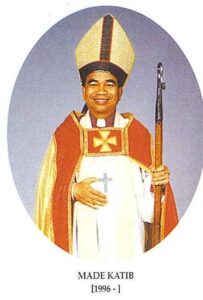 “At present, Bishop Made is kept extremely busy in exercising his episcopal duties over the large Diocese of Kuching, comprising Sarawak and the nation of Brunei.” Made was born at Senah Negeri (Annah Rais) on 23rd January 1942, the only son of Katib ak Nanja and Nyang ak Janggok.
“At present, Bishop Made is kept extremely busy in exercising his episcopal duties over the large Diocese of Kuching, comprising Sarawak and the nation of Brunei.” Made was born at Senah Negeri (Annah Rais) on 23rd January 1942, the only son of Katib ak Nanja and Nyang ak Janggok.
In 1950, he was enrolled in the Mission school opened by Ahtos Joshua at Annah Rais. Later, the school moved to Padawan in 1953. In January 1954, he was enrolled at St. Thomas’ School and admitted to Primary 5A. He went on to St. Thomas’ Secondary School, where he completed his Higher School Certificate (A-Level) in 1962.
In September 1963, he entered Leeds University in England, under S.P.G. scholarship, where he read History and English, graduating in July, 1966. He had his theological training at Mirfield Theological College, from September 1966 till July 1968. He also sat for the General Ordination Examination (GOE) in 1968.He returned to the Diocese in August 1968, and was made deacon on 22 September 1968 by Bishop Allenby at the Cathedral. He was ordained priest by Bishop Basil Temenggong on 17 August 1969. He served as an assistant priest at the Cathedral until December 1970.
He then served as a lecturer and chaplain at the House of the Epiphany in 1971 and 1972, following the re-opening of the College. On December 1972, he was transferred to Betong and served as an assistant priest to Fr. Gawili. He then took over as priest in charge of Betong, following Gawili’s departure in August 1973. He remained in Betong until 31 July 1981, when he was transferred back to the Cathedral. He was installed as Dean on 9 August 1981. He was consecrated as the Assistant Bishop on 23 February 1992 at the Cathedral, and was subsequently posted back to Betong to act as Vicar of the parish. He was enthroned as the 12th Bishop of the Diocese of Kuching on 30 November 1995, following the retirement of Bishop John Leong earlier in July.
In February 1966, the Diocese of Kuching became a part of the Province of South East Asia, with the neighbouring Dioceses of Sabah, West Malaysia, and Singapore. At the present Bishop Made is kept extremely busy in exercising the sole episcopal oversight over the large Diocese of Kuching, comprising Sarawak and the nation of Brunei.
He was awarded the Pegawai Bintang Sarawak (PBS) in 1991 and the Pingat Terpuji Jubli Perak (JPT) in 1988. He is married to Matilda Ng, from Betong, on 12 May 1979, and they have one daughter, Elvina Mary.
The Right Rev’d Datuk Made Katib, passed away at the age of 71 on 20th January 2013. He dedicated 38 years of his life to the Ministry. He was survived by his wife, Matilda Thomas Ng, and, daughter, Elvina Mary.
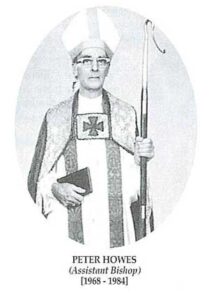 Peter Howes was consecrated Assistant Bishop in St Thomas’ Cathedral on the Feast of Transfiguration in 1976. He came to Sarawak in 1937, after his ordination in 1935 at Durham, in England. On arrival in Sarawak, was sent to Betong to assist Father Stonton at St. Augustine’s Church and School. From there he was posted to Kuap, and given the task of taking charge of the whole Bidayuh area. He started translating the New Testament into Biatah, a Bidayuh dialect. In the latter part of 1930s, and before the start of the Second World War, Howes visited other churches and did ‘relief duty’ for priests who went on leave. That took him to Sandakan, Betong and other outstations.When the war broke out, Howes was in Kuap, working hard in his garden to be self-supporting. Then in January 1942, he was arrested by the Japanese at Kuap and interned. While at the infamous Batu Lintang Prison Camp, he conducted eucharist services for the prisoners, together with Biship Hollis and other missionaries.The war ended in 1945, and the prisoners of war were immediately sent to Labuan. Howes soon returned to Sarawak to begin reconstruction of the Church.
Peter Howes was consecrated Assistant Bishop in St Thomas’ Cathedral on the Feast of Transfiguration in 1976. He came to Sarawak in 1937, after his ordination in 1935 at Durham, in England. On arrival in Sarawak, was sent to Betong to assist Father Stonton at St. Augustine’s Church and School. From there he was posted to Kuap, and given the task of taking charge of the whole Bidayuh area. He started translating the New Testament into Biatah, a Bidayuh dialect. In the latter part of 1930s, and before the start of the Second World War, Howes visited other churches and did ‘relief duty’ for priests who went on leave. That took him to Sandakan, Betong and other outstations.When the war broke out, Howes was in Kuap, working hard in his garden to be self-supporting. Then in January 1942, he was arrested by the Japanese at Kuap and interned. While at the infamous Batu Lintang Prison Camp, he conducted eucharist services for the prisoners, together with Biship Hollis and other missionaries.The war ended in 1945, and the prisoners of war were immediately sent to Labuan. Howes soon returned to Sarawak to begin reconstruction of the Church.
He visited Taee on 26 December 1945, and pleasantly discovered that the Church was active during the war under Oscar Sindon. At that service he was able to give communicants to 180 persons, out of the 300 who attended.
The post-war period until early 1950s saw the Church progressing rapidly in the Bidayuh area under his leadership. Howes had to attend to several requests from villagers who wanted to have schools or chapels established.
In 1952, Howes was appointed to start a theological school for the training of local priests. Hence the establishment of the House of Epiphany in September, with Howes becoming the first Warden. During the Centenary Celebrations of the Diocese in 1955, six canonries were created, and Howes was one of them.
On return from his leave in 1956. Howes suggested that the Church should start a scheme to assist in the development of poor areas of Padawan. The Colonial Government supported the idea for the Padawan Community Development Programme: with the Church providing the staff and the Government giving the funds. Howes headed a team of Development Officers from England in Providing medical services and agricultural training. In 1960, the Government took over the Programme and Howes ended his appointment as Development Officer.
In the 1970s, he was appointed Archdeacon of Sarawak and Brunei, and later Archdeacon of Brunei and North Sarawak, where he visited and assisted the Churches in Brunei, Limbang, Miri, and Bintulu.
Peter Howes retired in 1981. Since then he has visited Sarawak several times. In 1985, during the interregnum after the demise of Bishop Basil Temenggong, he was sent to Sarawak, as the Archbishop of Canterbury’s Commissary.
Recalling in his autobiography of his consecration as Assistant Bishop in 1976, he says:
“So, after 40 years in the country, I found myself confirming the children and even grand children of those I had once taught. The lot, one felt, could hardly fall on any ground fairer than that…All told, before going on leave in April ‘77, I had visited 24 centres, and had confirmed 1548 candidates.”
(See: Peter H.H.Howes, In a Fair Ground..,, Alpine; London, 1995, p.390).
